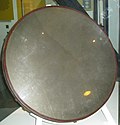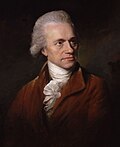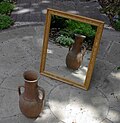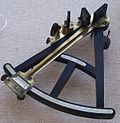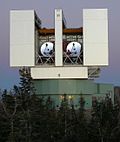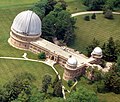Speculum metal is a mixture of around two-thirds copper and one-third tin, making a white brittle alloy that can be polished to make a highly reflective...
11 KB (1,320 words) - 13:58, 14 June 2024
coloured Speculum literature, a medieval genre Speculum metal, an alloy containing copper and tin used for making all-metal mirrors "Speculum", a song...
731 bytes (126 words) - 01:17, 12 January 2023
A speculum (Latin for 'mirror'; pl.: specula or speculums) is a medical tool for investigating body orifices, with a form dependent on the orifice for...
13 KB (1,451 words) - 13:08, 27 August 2024
time of Newton to the 1800s, the mirror itself was made of metal – usually speculum metal. This type included Newton's first designs and the largest telescope...
33 KB (3,918 words) - 17:54, 3 September 2024
During the period 1850–1900, reflectors suffered from problems with speculum metal mirrors, and a considerable number of "Great Refractors" were built...
74 KB (9,254 words) - 07:09, 17 August 2024
List of named alloys (section Alloys by base metal)
and phosphorus) Ormolu (zinc) Silicon bronze (tin, arsenic, silicon) Speculum metal (tin) White bronze (tin, zinc) Constantan (nickel) Copper hydride (hydrogen)...
22 KB (1,378 words) - 00:21, 2 September 2024
List of copper alloys (redirect from Ounce metal)
on the surface of the metal. Bell metal Brastil Phosphor bronze Nickel bronzes, e.g. nickel silver and cupronickel Speculum metal UNS C69100 Copper is...
22 KB (783 words) - 00:31, 22 August 2024
exact metals used in the alloy are maintained as family secrets; metallurgists suggest that the alloy is a mix of copper and tin, so a type of speculum metal...
5 KB (413 words) - 22:44, 2 April 2024
telescopes that succeeded it because of the poor performance of its speculum metal mirror. Chronological list of optical telescopes by historical significance...
23 KB (654 words) - 19:42, 9 October 2023
Isaac Newton built his first reflecting telescope. He chose an alloy (speculum metal) of tin and copper as the most suitable material for his objective mirror...
17 KB (1,937 words) - 18:50, 18 March 2024
telescopes. He would spend up to 16 hours a day grinding and polishing the speculum metal primary mirrors. He relied on the assistance of other family members...
78 KB (8,492 words) - 11:10, 5 September 2024
Bronze mirror (category Ancient art in metal)
remained common in many parts of the world until the 19th century. Speculum metal is a very hard high-tin bronze-type alloy, with about 30% tin rather...
15 KB (1,814 words) - 02:55, 13 April 2024
Bronze (category Coinage metals and alloys)
aluminium bronze, phosphor bronze, manganese bronze, bell metal, arsenical bronze, speculum metal, bismuth bronze, and cymbal alloys. Copper-based alloys...
44 KB (4,885 words) - 21:25, 8 September 2024
ground his own mirrors out of a custom composition of highly reflective speculum metal, using Newton's rings to judge the quality of the optics for his telescopes...
144 KB (14,725 words) - 08:05, 8 September 2024
and India. Mirrors of speculum metal or any precious metal were hard to produce and were only owned by the wealthy. Common metal mirrors tarnished and...
118 KB (13,083 words) - 17:53, 8 August 2024
used a custom composition of metal consisting of six parts copper to two parts tin, an early composition of speculum metal. He devised means for shaping...
14 KB (1,927 words) - 21:49, 24 June 2023
problems seen in refractors, were hampered by the use of fast tarnishing speculum metal mirrors employed during the 18th and early 19th century—a problem alleviated...
41 KB (3,925 words) - 16:38, 14 August 2024
Proctoscopy (redirect from Kelly's rectal speculum)
non-disposable Kelly's rectal speculum, named after the American gynecologist Howard Atwood Kelly, is the most commonly used speculum for proctoscopy. Some proctoscopes...
4 KB (406 words) - 01:52, 22 June 2024
apertures than metal, and later glass, mirror telescopes. The technology for silver-coating glass mirrors, more reflective than speculum metal and not subject...
23 KB (1,000 words) - 21:26, 11 April 2024
is a spherical or parabolic shaped disks of polished reflective metal (speculum metal up to the mid 19th century), or in later telescopes, glass or other...
7 KB (595 words) - 17:11, 22 January 2024
elements. Prisms provide advantages over mirrors in an era when polished speculum metal mirrors were inferior and both the silvering of a mirror and the production...
24 KB (3,035 words) - 05:39, 6 May 2024
romanized, include: "moon-mirror" "Yin mirror" "metal speculum for gathering water from the moon" "square speculum" "square receptacle" Metaphorically using...
63 KB (9,277 words) - 17:15, 17 August 2024
techniques of casting, grinding and polishing large telescope mirrors from speculum metal, and constructed steam-powered grinding machines for parabolic mirrors...
11 KB (1,330 words) - 04:08, 12 August 2024
not published their methods. Details of the metal, casting, grinding and polishing of the 3-ton 'speculum' were presented in 1844 at the Belfast Natural...
16 KB (1,433 words) - 22:16, 15 August 2024
The Speculum Maius or Majus (Latin: "The Greater Mirror") was a major encyclopedia of the Middle Ages written by Vincent of Beauvais in the 13th century...
23 KB (2,860 words) - 09:44, 21 May 2024
to their difficulty of construction and the poor performance of the speculum metal mirrors used it took over 100 years for reflectors to become popular...
58 KB (8,133 words) - 23:45, 21 July 2024
many advantages including a far better site, a glass mirror instead of speculum metal, and a precision mount which could accurately track any direction in...
35 KB (3,886 words) - 19:47, 12 July 2024
Gregorian telescopes with parabolic mirrors made from the highly reflective speculum metal. The Gregorian telescope consists of two concave mirrors: the primary...
7 KB (705 words) - 04:48, 22 June 2024
died in 1897. Glass lens telescopes had a good reputation compared to speculum metal and silver on glass mirror telescopes, which had not quite proven themselves...
64 KB (5,878 words) - 23:37, 20 August 2024

